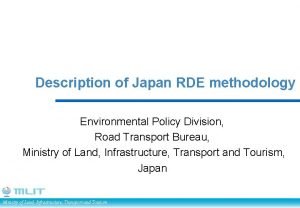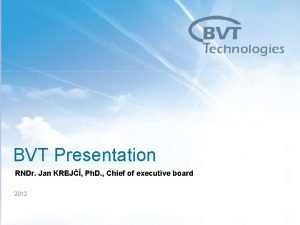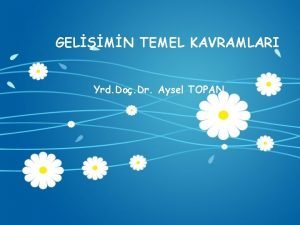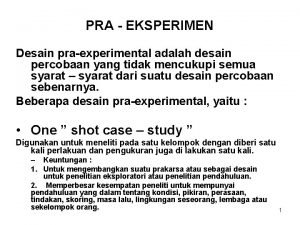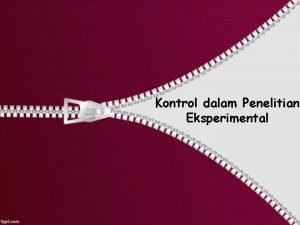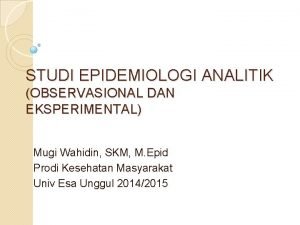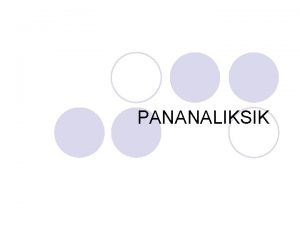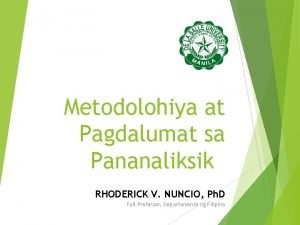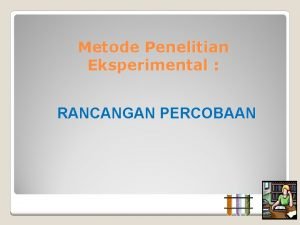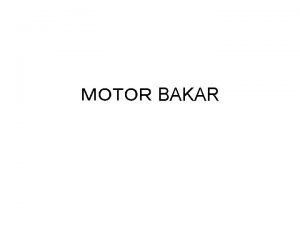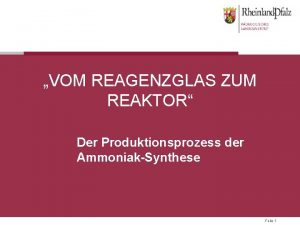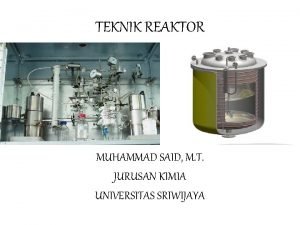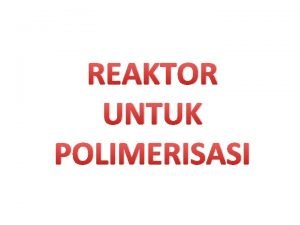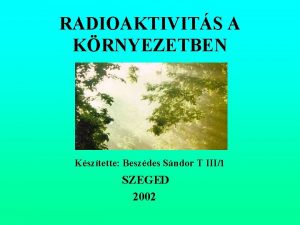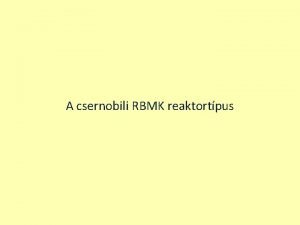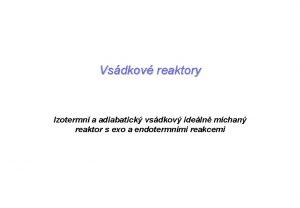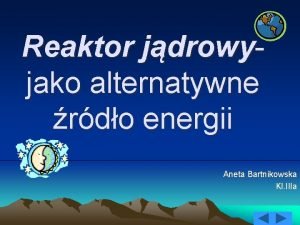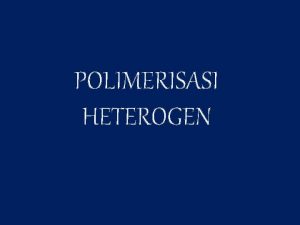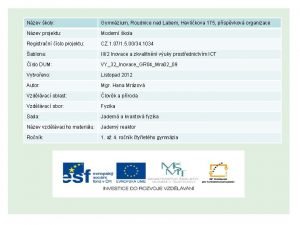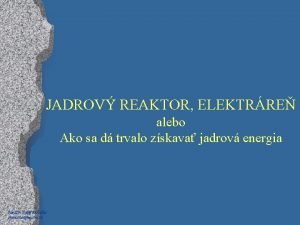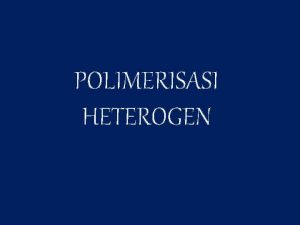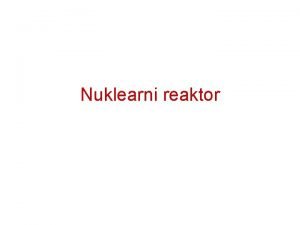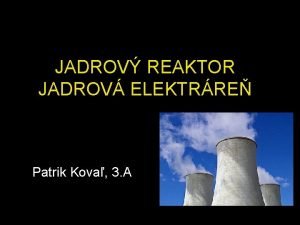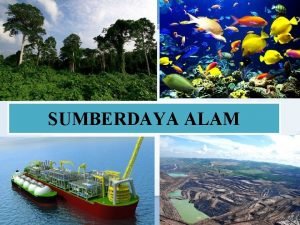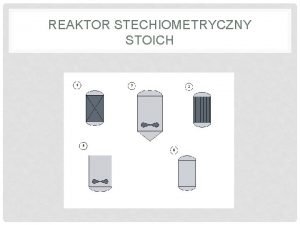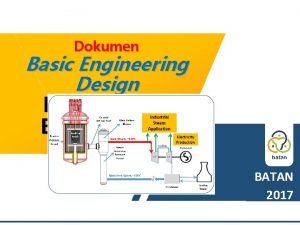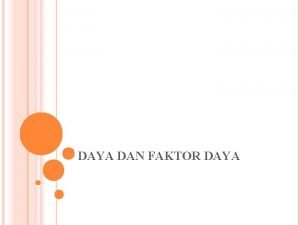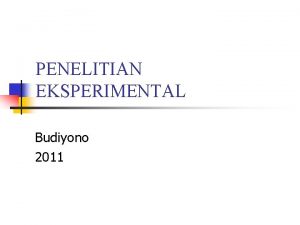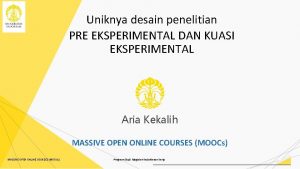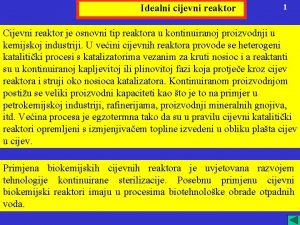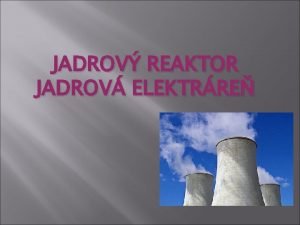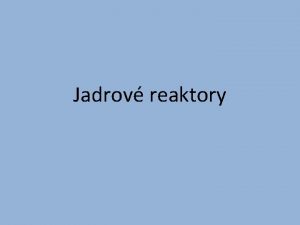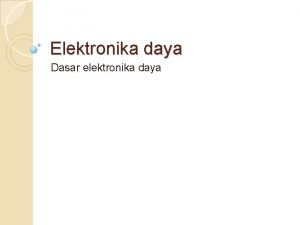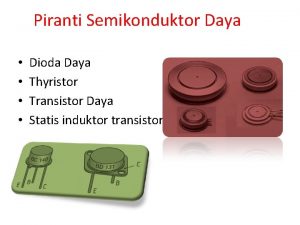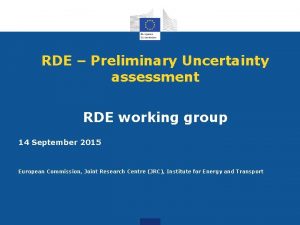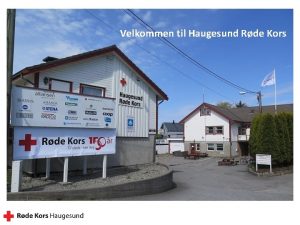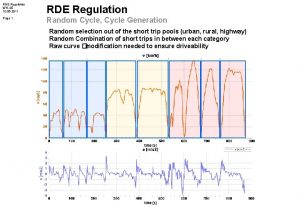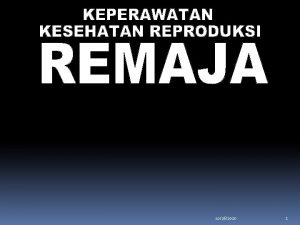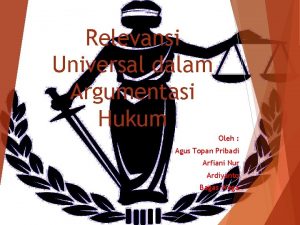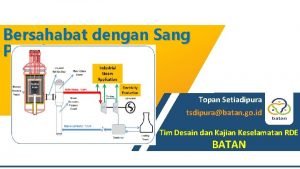Design Status of Reaktor Daya Eksperimental RDE Topan





































- Slides: 37

Design Status of Reaktor Daya Eksperimental (RDE) Topan Setiadipura Wednesday, 23 August 2017 Tim Desain dan Analisis Keselamatan RDE Melia Purosani Hotel, Yogyakarta BATAN Email: tsdipura@batan. go. id

Content: RDE’s Objective RDE Design From Conceptual to Basic Design Resume www. batan. go. id 06/03/2017 2

RDE’s Objectives • Provides a strong foundation for the development of smallmedium size nuclear power plants in order to meet the electricity supply throughout the nation. • Contributes to the optimization of national natural resource processing using cogeneration capability. • Accumulating nuclear human resource capability in the mastery of design engineering, reactor technology, project management, maintenance and operation of nuclear power plants. • Increase (public) acceptance of nuclear power plants. • Realizing Indonesia as a nuclear energy center of excellence in Asia Pacific. www. batan. go. id 06/03/2017 3

Reaktor Daya Eksperimental (RDE) Design A pebble bed high temperature reactor design for prototype of Indonesian Co-Generation Nuclear Power Plant www. batan. go. id 06/03/2017 4

RDE Building Arrangement Reactor auxiliary building Reactor building Helium storage Turbine building Transformer Spent fuel element storage Gate house Office and staff building www. batan. go. id Reactor building annex Central control (Switchgear) building

www. batan. go. id

Going Deep into Reactor Building www. batan. go. id

Going Deep into Reactor Building www. batan. go. id

Cross Section of Reactor Building underground www. batan. go. id

Cross Section of Reactor Building underground www. batan. go. id

RDE General System Co-axial Hot Gas Duct Reactor Pressure Vessel Main Helium Blower Main Steam, Experimental Industrial Steam Application Electricity Production ~520 o. C Steam Generator Pressure Vessel Turbine HP Generator LP Main Feed Water, ~145 o. C Condenser www. batan. go. id Cooling Tower

RDE General System Co-axial Hot Gas Duct Reactor Pressure Vessel Main Helium Blower Main Steam, Experimental Industrial Steam Application Electricity Production ~520 o. C Steam Generator Pressure Vessel Turbine HP Generator LP Main Feed Water, ~145 o. C Condenser www. batan. go. id Cooling Tower

RDE General Design Data www. batan. go. id 06/03/2017 13

RPV Internals Contro Rod Driver Mechanism Control Rod Columns Helium coolant columns Metallic supports www. batan. go. id Reactor Core Graphite Reflector surrounding the core Fuel insertion pipe Top and bottom He plennum Fuel discharge column RPV’s cross section

RPV Internals Control Rod Drive Mechanism Control Rod Colums Helium Coolant Column Metallic Components /Supports www. batan. go. id Core Reactor Graphite reflector, surrounding the core Fuel insertion device Upper and lower helium plennum Fuel discharge columns RPV’s Cross Section

RPV Internals and Passive Safety Features: 1. 2. Slim reactor core diameter (~1. 8 m): thinner heat transfer path. Significant graphite composition with physical characteristic: a) High heat conductivity: good heat transfer capability b) High heat capacity: slower temperature increase for the same given energy. RDE design able to transfer decay heat only by natural mechanism without any active systems. Fukushima accident scenario will not occurred in RDE www. batan. go. id

RPV Internals and Passive Safety Features: 1. 2. Slim reactor core diameter (~1. 8 m): thinner heat transfer path. Significant graphite composition with physical characteristic: a) High heat conductivity: good heat transfer capability b) High heat capacity: slower temperature increase for the same given energy. RDE design able to transfer decay heat only by natural mechanism without any active systems. Fukushima accident scenario will not occurred in RDE www. batan. go. id

Primary Helium Cycle A : Helium (250 o. C) flow in the outer side of Co-axial hot gas duct, guided to the lower part of Reactor Pressure Vessel (RPV). B A C Main Steam, ~520 o. C D E B : From bottom part of RPV, helium flows up through He-channel in the graphite reflector part, then mixed in the upper plenum. C : Helium flows down in the reactor core, absorbing heat from the nuclear reaction occurred in the pebble fuel. D : Helium with average temp. of 700 o. C mixes in the bottom plenum, then flow F through the center-pipe of co-axial hot gas Main Feed Water, ~145 o. C duct to the steam generator (SG). F : Feed water becomes superheated steam E : Hot helium transfers heat to the feed after receiving heat from the helium, then flows water/steam in the SG, then flown-back to the core to the turbine/cogeneration system. by the main blower. www. batan. go. id

Primary Helium Cycle A : Helium (250 o. C) flow in the outer side of Co-axial hot gas duct, guided to the lower part of Reactor Pressure Vessel (RPV). B A C Main Steam, ~520 o. C D E B : From bottom part of RPV, helium flows up through He-channel in the graphite reflector part, then mixed in the upper plenum. C : Helium flows down in the reactor core, absorbing heat from the nuclear reaction occurred in the pebble fuel. D : Helium with average temp. of 700 o. C mixes in the bottom plenum, then flow F through the center-pipe of co-axial hot gas Main Feed Water, ~145 o. C duct to the steam generator (SG). F : Feed water becomes superheated steam E : Hot helium transfers heat to the feed after receiving heat from the helium, then flows water/steam in the SG, then flown-back to the core to the turbine/cogeneration system. by the main blower. www. batan. go. id

RDE Fuel. Zone (Graphite Matrix) Graphite Shell 3 cm 2. 5 cm Pebble ball fuel [OD = 6 cm] Pebble fuel ball Nuclear Each pebble ball divide into two reactor core fuel zone contains: part: filled with - ~ 8335 TRISO 1. Outer graphite 27000 particles shell. pebble fuel - Total 5 g heavy 2. Inner fuel ball metal loading. zone. www. batan. go. id

RDE Fuel. Zone (Graphite Matrix) Graphite Shell 3 cm 2. 5 cm Pebble ball fuel [OD = 6 cm] Pebble fuel ball Nuclear Each pebble ball divide into two reactor core fuel zone contains: part: filled with - ~ 8335 TRISO 1. Outer graphite ~27000 particles shell. pebble fuel - Total 5 g heavy 2. Inner fuel ball metal loading. zone. www. batan. go. id

RDE Fuel: TRISO Particle (Tri-isotropic) : UO 2 Kernel: uranium oxide fuel material, for RDE 17% U-235 enrichment. Buffer : low density carbon layer (~1. 05 g/cm 3). Berfungsi menampung produk fisi dari kernel. Inner dan Outer Pyrolitic Carbon : pyrolitic carbon layer to mechanically strengthen the TRISO particle (density ~1. 75 g/cm 3). Silicon Carbide (Si. C): high density sillicon carbide layer (~3. 18 g/cm 3). Main constrain which avoid the fission product release to the environment even in the most severe accident. www. batan. go. id

RDE Fuel: TRISO Particle (Tri-isotropic) : TRISO fuel design guarantee the ‘contain’ safety aspect of RDE www. batan. go. id UO 2 Kernel: uranium oxide fuel material, for RDE 17% U-235 enrichment. Buffer : low density carbon layer (~1. 05 g/cm 3). Berfungsi menampung produk fisi dari kernel. Inner dan Outer Pyrolitic Carbon : pyrolitic carbon layer to mechanically strengthen the TRISO particle (density ~1. 75 g/cm 3). Silicon Carbide (Si. C): high density sillicon carbide layer (~3. 18 g/cm 3). Main constrain which avoid the fission product release to the environment even in the most severe accident.

RDE Fuel Handlings 4 5 1 6 2 3 7 www. batan. go. id 8 9 RDE fuel handling (main) components : 1. Fresh fuel 2. Fuel distributor: dengan sistem pneumatik mendistribusikan bahan bakar sesuai skema operasi dan derajat burnup bahan bakar. 3. Burnup measurement device: mengukur derajat burnup setiap bahan bakar. 4. Reactor Core: tempat bahan bakar menghasilkan energi dengan mengalami reaksi fisi berantai. 5. Singulator: alat untuk mengatur aliran bahan bakar sehingga bergerak satu-satu (tunggal). 6. Failed fuel separator: alat untuk memisahkan bahan bakar yang geometrinya rusak. 7. Failed fuel cask: Tempat menyimpan bahan bakar yang rusak geometri fisiknya. 8. Dummy graphite cask: tempat menyimpan bahan bakar dummy grafit. 9. Spent fuel cask: menyimpan bahan bakar bekas dengan derajat burnup yang sudah melebihi batas tertentu.

RDE Fuel Handlings D: From the singulator, fuels continue (one-by -one) to the failed fuel separator. 4 F: Dummy graphite fuel will be collected in the dummy fuel cask. 5 1 6 2 3 7 www. batan. go. id 8 9 E: Failed fuels will be collected in the failed fuel separator, others will be directed to the B: In the reactor core, fuels are moving C: From bottom of the core, fuel will go distributor. G: Fuel with enough-burnup, will be collected downward while generating power via fission A: Fresh fuel will be under-target) directed toup fuel H: Fuel with low (or burnup will out via the fuel discharge tube to in the spent fuel cask. reactions. distributor, to the core using a be returned then backelevated to the core together with the singulator. pneumatic fresh fuel. system.

From Conceptual Design to Basic Design Engineering of RDE The design team comprise of 31 staff from broad range of field: Nuclear and safety, process eng. , mechanical eng. , I&C, electrical, civil, piping, engineering drawing (drafter), also the quality and project/design management. www. batan. go. id 26

Motivations The design engineering documents is needed for the To. R of the EPC Contract. Also part of the requirements of the ‘design approval’ by BAPETEN. Basic Engineering Design of RDE is a strategic interim results: Enhancing BATAN capability as R&D organization, in particular to play the role as nuclear reactor designer. Accumulation of Design engineering experience for BATAN human resources. To build trust from other national stake holders: govt. (central or local), private company, etc. www. batan. go. id 27

Design Steps Conceptual Design Basic Design Detailed Design Construction Renuko (2015) BATAN ? ? ? (2017) Vendor (2018) Vendor (2019 -2022) Design Approval Construction Permit - Tech. Attachment of Bidding Doc. - Component Level cost Estimation www. batan. go. id

Reference & Tech. Accumulation RDE Pre-Project at 2015: 7 Dokumen FS, Konseptual Desain, FEED, DID, DUR, SAR Draft of (construction) Licensing Docs. at 2016: IAEA Review on Conceptual Design (performed in 2016) Public documents on Pebble Bed HTGR RGTT 200 K development docs. www. batan. go. id 29

Basic Design dan EPC Conceptual Designer, scientific community. Basic Designer IP owner. Detail Design www. batan. go. id EPC Contractor Engineering Procurement Construction 30

Basic Design dan EPC Conceptual Design Desainer, komunitas ilmiah. Basic Design Desainer Pemilik IP atas desain. Detail EPC Contractor Engineering Design www. batan. go. id Procurement INET CHINERGY Construction 31

Process Engineering Workflow www. batan. go. id 32

Process Engineering Milestone Process Flow Diagram (PFD) ~17 PFD drawings Piping & Instrumentation Diagram (P&ID) ~40 PFD drawings www. batan. go. id Other aspect development: - I&C System - Electrical System - Mechanical spec. and analysis - Piping spec. and analysis - Civil design Component Level Cost Estimation

Excerpt of RDE’s PFD Primary Helium Cycle www. batan. go. id 06/03/2017 34

Resume of Design Status ? Basic engineering design development is in progress, it is scheduled to be finished in September 2017. Related on the project: applying design from Vendors for the RDE EPC Phase is still an option. www. batan. go. id 5/22/2021

Thank You Tim Desain dan Kajian Keselamatan RDE Gd. 80 PUSPIPTEK AREA, Tangerang Selatan, BADAN TENAGA NUKLIR BANTEN 15310 NASIONAL (021) 756 0912 | Fax. (021) 756 0913 tsdipura@batan. go. i d www. batan. go. id

Jl. Kuningan Barat, Mampang Prapatan Jakarta, 12710 (021) 525 1109 | Fax. (021) 525 1110 contact us humas@batan. go. i d @humasbatan Humas Batan badan_tenaga_nuklir_nasional Humas Batan www. batan. go. id
 Rde
Rde Rde
Rde Bvt transport
Bvt transport Aysel topan
Aysel topan Pengantar desain eksperimen
Pengantar desain eksperimen Eksperimental murni adalah
Eksperimental murni adalah Tujuan randomisasi penelitian
Tujuan randomisasi penelitian Epidemiologi eksperimen adalah
Epidemiologi eksperimen adalah Ano ano ang mga layunin ng pananaliksik
Ano ano ang mga layunin ng pananaliksik Metodolohiya kahulugan
Metodolohiya kahulugan Eksperimental
Eksperimental Rumus tekanan efektif rata-rata
Rumus tekanan efektif rata-rata Apakah yang dimaksud dengan daya lenting ekosistem
Apakah yang dimaksud dengan daya lenting ekosistem Sapratibandha daya and apratibandha daya
Sapratibandha daya and apratibandha daya Classification of property law
Classification of property law Elektron valensi fluor
Elektron valensi fluor Daya tampung populasi
Daya tampung populasi Reaktorofen
Reaktorofen Perbedaan reaktor cstr dan pfr
Perbedaan reaktor cstr dan pfr Reaktor szklany z płaszczem
Reaktor szklany z płaszczem Contoh soal reaktor batch
Contoh soal reaktor batch Tórium reaktor
Tórium reaktor Kaszkád reaktor
Kaszkád reaktor Pozitív üregtényező
Pozitív üregtényező Vsádkový reaktor
Vsádkový reaktor Reaktor rbmk
Reaktor rbmk Reaktor berjaket
Reaktor berjaket Jaderný reaktor
Jaderný reaktor Reaktör
Reaktör Reaktor
Reaktor Kotlasti reaktor
Kotlasti reaktor Viskositas air
Viskositas air Kotlasti reaktor
Kotlasti reaktor Patrik kovaľ
Patrik kovaľ Thorium reaktor
Thorium reaktor Etika sumber daya manusia
Etika sumber daya manusia Peta konsep sda
Peta konsep sda Jelaskan pengertian sumber daya usaha menurut zakky fathoni
Jelaskan pengertian sumber daya usaha menurut zakky fathoni

